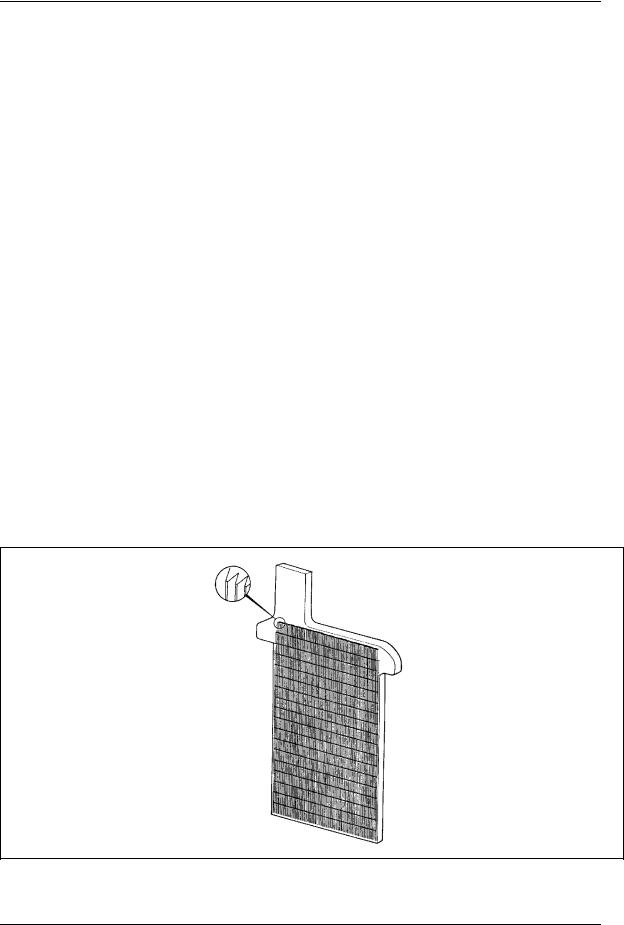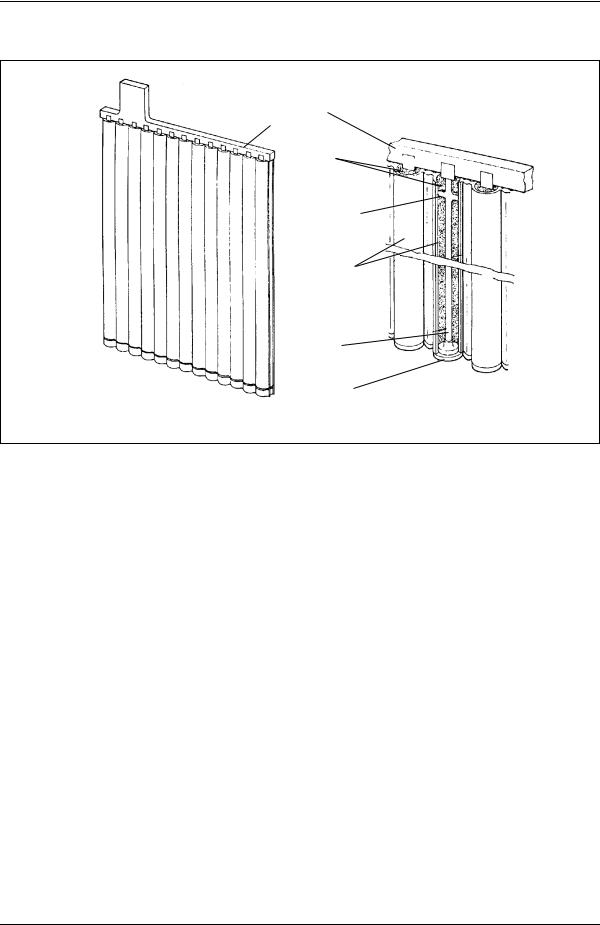
- •FOREWORD
- •OVERVIEW
- •TABLE OF CONTENTS
- •LIST OF FIGURES
- •LIST OF TABLES
- •INTRODUCTION
- •DEFINITIONS
- •BATTERY COMPONENTS AND OPERATION
- •Cells vs. Batteries
- •Primary and Secondary Cells and Batteries
- •Battery Components
- •Cell and Battery Voltage
- •Capacity and Battery Ratings
- •Series and Parallel Connections
- •LEAD-ACID BATTERY TYPES
- •Flooded Lead-Acid Batteries
- •Sealed Lead-Acid Batteries
- •OPERATION AND CONSTRUCTION
- •Lead-Acid Battery Active Materials
- •Electrochemistry of the Lead-Acid Cell
- •Negative and Positive Plate Construction Methods
- •Antimony/Calcium/Selenium/Tin Alloying
- •Specific Gravity
- •Effects of Discharge Rate and Temperature on Capacity and Life
- •APPLICATIONS
- •Starting, Lighting, and Ignition
- •Industrial
- •Traction
- •Stationary
- •Portable
- •SIZING AND SELECTION
- •MAINTENANCE
- •General
- •Matching the Charger to Battery Requirements
- •Avoiding Overdischarge
- •Maintaining Electrolyte Levels
- •Cleaning
- •Avoiding High Temperatures
- •Supplying an Equalizing Charge
- •Safety Precautions
- •Testing
- •STORAGE, TRANSPORTATION, AND DISPOSAL
- •Storage
- •Transportation
- •Disposal
- •BIBLIOGRAPHY
- •CONCLUDING MATERIAL

OPERATION AND CONSTRUCTION |
DOE-HDBK-1084-95 |
Lead-Acid Storage Batteries |
|
|
|
Negative and Positive Plate Construction Methods
The simplest method for the construction of lead-acid battery electrodes is the planté plate, named after the inventor of the lead-acid battery. A planté plate is merely a flat plate composed of pure lead. Since the capacity of a lead-acid battery is proportional to the surface area of the electrodes that is exposed to the electrolyte, various schemes are employed to increase the surface area of the electrodes per unit volume or weight. Planté plates are grooved or perforated to increase their surface area. A typical planté plate is shown in Figure 4.
The most commonly used method to increase surface area is to make the active material into a paste that acts like a sponge where the electrolyte fills all the pores. The paste, or active material, is mounted into a frame or grid structure that mechanically supports it and serves as the electrical conductor carrying the current during both the charge and discharge cycle. The most commonly used plate today is the pasted plate, also known as the flat plate. This grid structure is a lattice-work that resembles the cross section of a honeycomb, with the paste filling all of the rectangular windows on the structure. Figure 5 shows a typical construction of a pasted plate grid. The flat plate construction is used as the negative electrode plate in almost all cases, and serves as the positive plate in most standby applications.
Figure 4. Typical planté plate.
Batteries |
Page 14 |
Rev. 0 |

Lead-Acid Storage Batteries |
DOE-HDBK-1084-95 |
OPERATON AND CONSTRUCTION |
|
|
|
|
|
|
|
|
|
|
|
|
|
Figure 5. Typical construction of a pasted plate grid.
Positive electrodes are usually of pasted plate or tubular construction. Tubular electrodes are popular positive plates for heavy cycling applications. This construction uses a frame structure consisting of a series of vertical spines connected to a common bus. The paste is held in micro-porous, non-conductive tubes which are placed over the individual spines. A simplified view of tubular plate construction is shown in Figure 6. Regardless of the plate type used, the capacity of any battery is increased by adding multiple plates in parallel.
Antimony/Calcium/Selenium/Tin Alloying
The grid structure in both pasted and tubular plate batteries is made from a lead alloy. A pure lead grid structure is not strong enough by itself to stand vertically while supporting the active material. Other metals in small quantities are alloyed with lead for added strength and improved electrical properties. The most commonly alloyed metals are antimony, calcium, tin, and selenium.
Rev. 0 |
Page 15 |
Batteries |

OPERATION AND CONSTRUCTION |
DOE-HDBK-1084-95 |
Lead-Acid Storage Batteries |
|
|
|
Connector bus
Active material
Centering projections
Porous separators 
Axial lead current collector
 End cap
End cap
Figure 6. Typical construction of a tubular plate.
The two most common alloys used today to harden the grid are antimony and calcium. Batteries with these types of grids are sometimes called "lead-antimony" and "leadcalcium" batteries. Tin is added to lead-calcium grids to improve cyclability. The major differences between batteries with lead-antimony and lead-calcium grids are as follows:
1.Lead-antimony batteries can be deep cycled more times than leadcalcium batteries.
2.Flooded lead-antimony batteries require more frequent maintenance as they near end-of-life since they use an increasing amount of water and require periodic equalization charges.
3.Lead-calcium batteries have lower self-discharge rates as shown in Figure 7 and therefore, will draw less current while on float charge than lead-antimony batteries.
4.Lead-calcium positive plates may grow in length and width because of grid oxidation at the grain boundaries. This oxidation is usually caused
Batteries |
Page 16 |
Rev. 0 |
